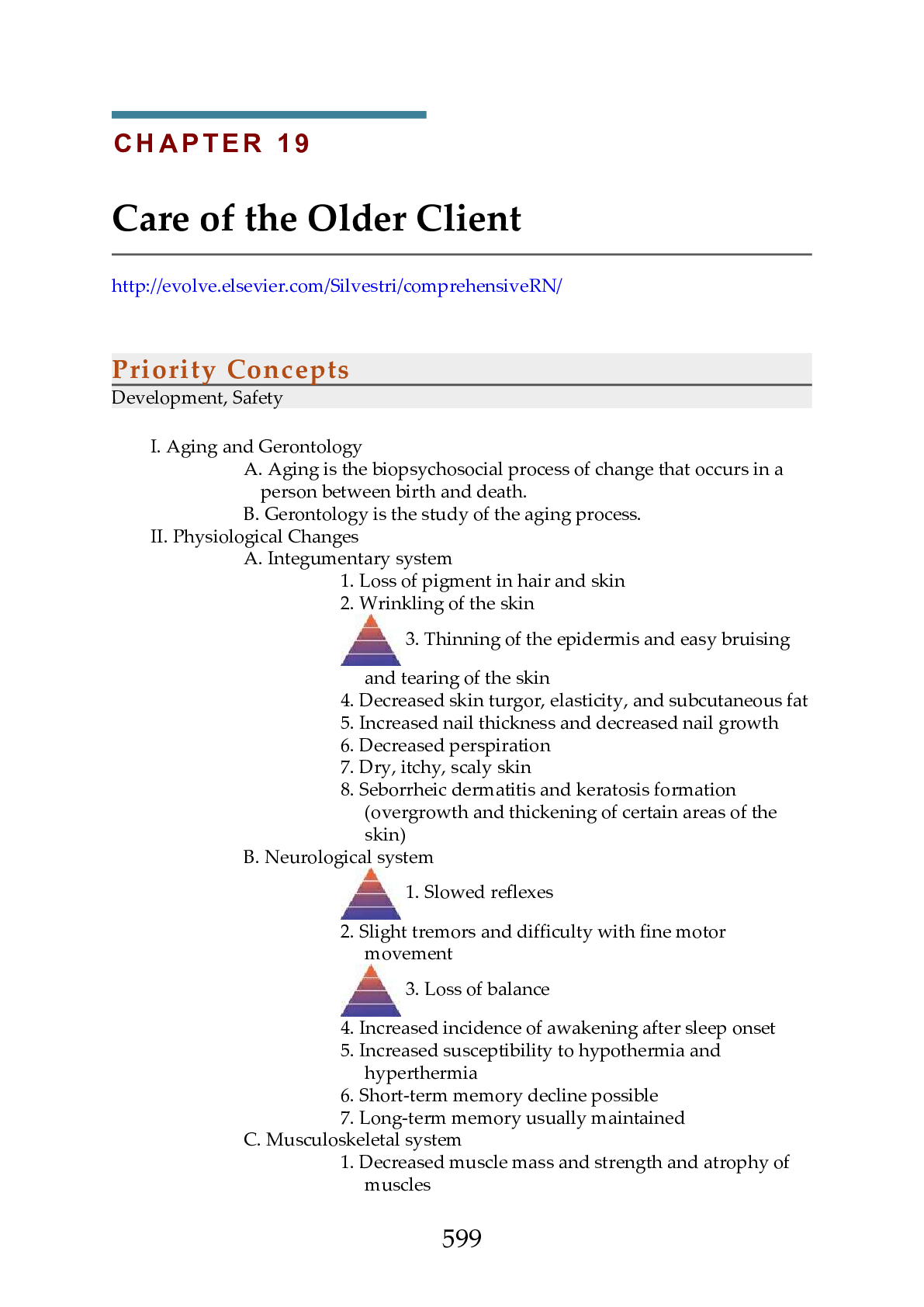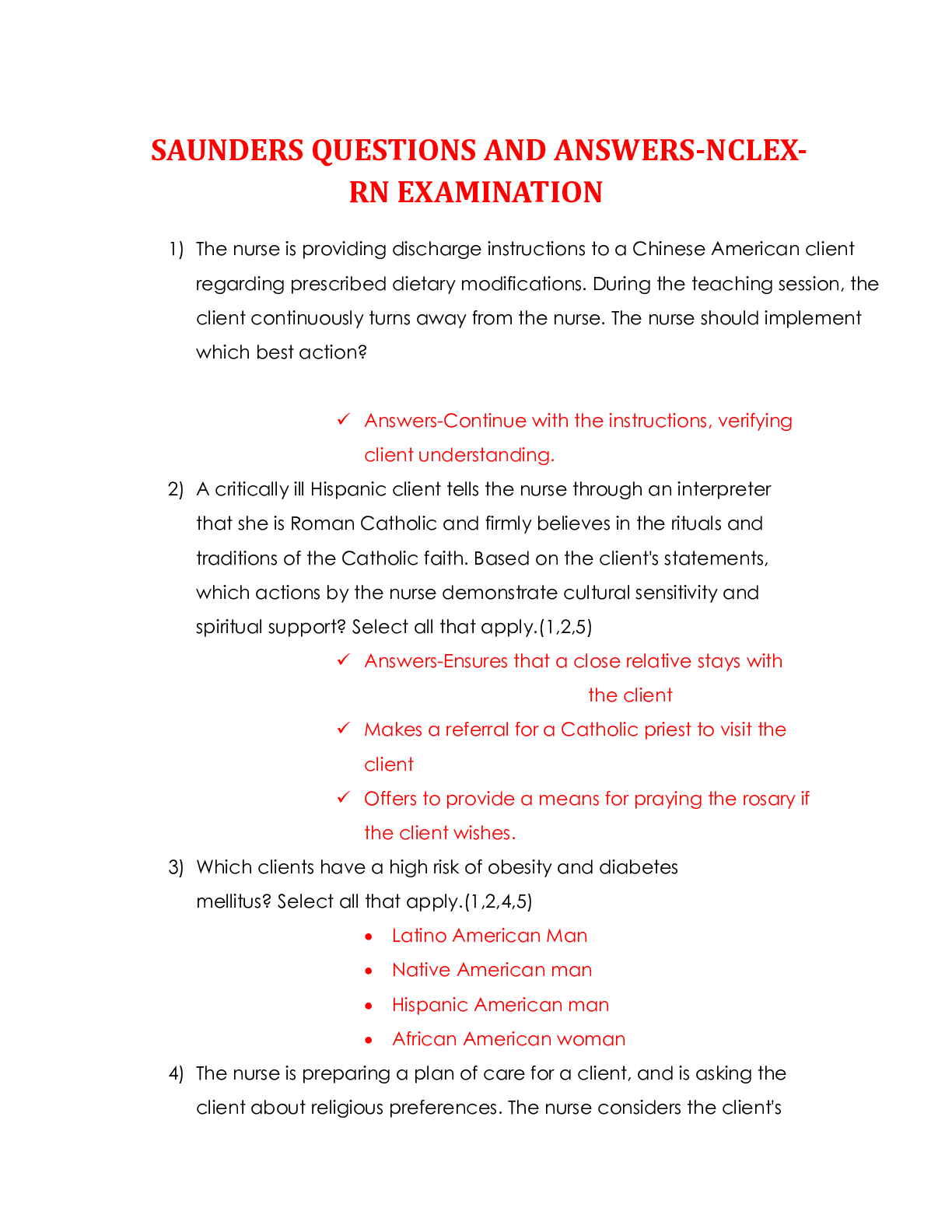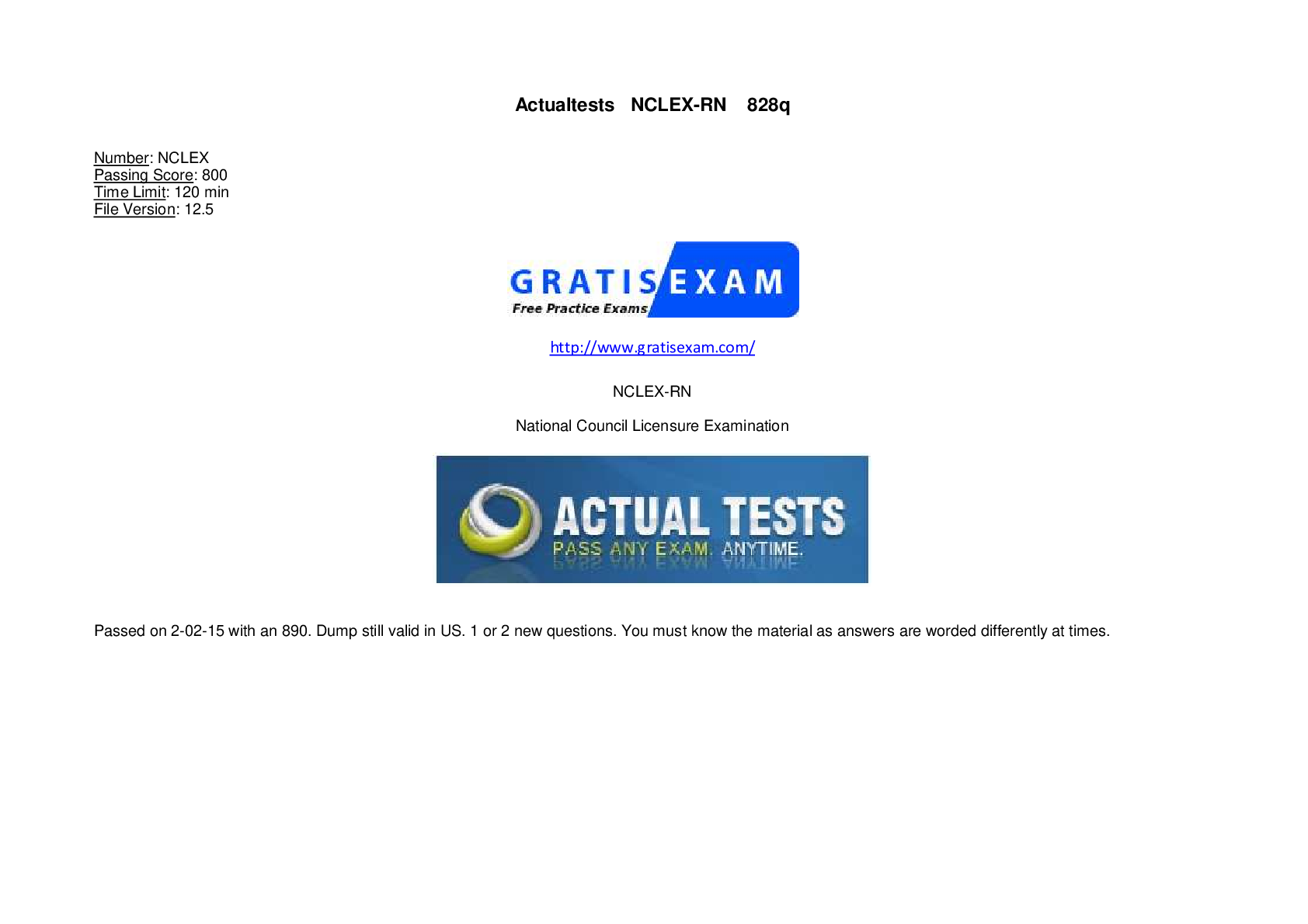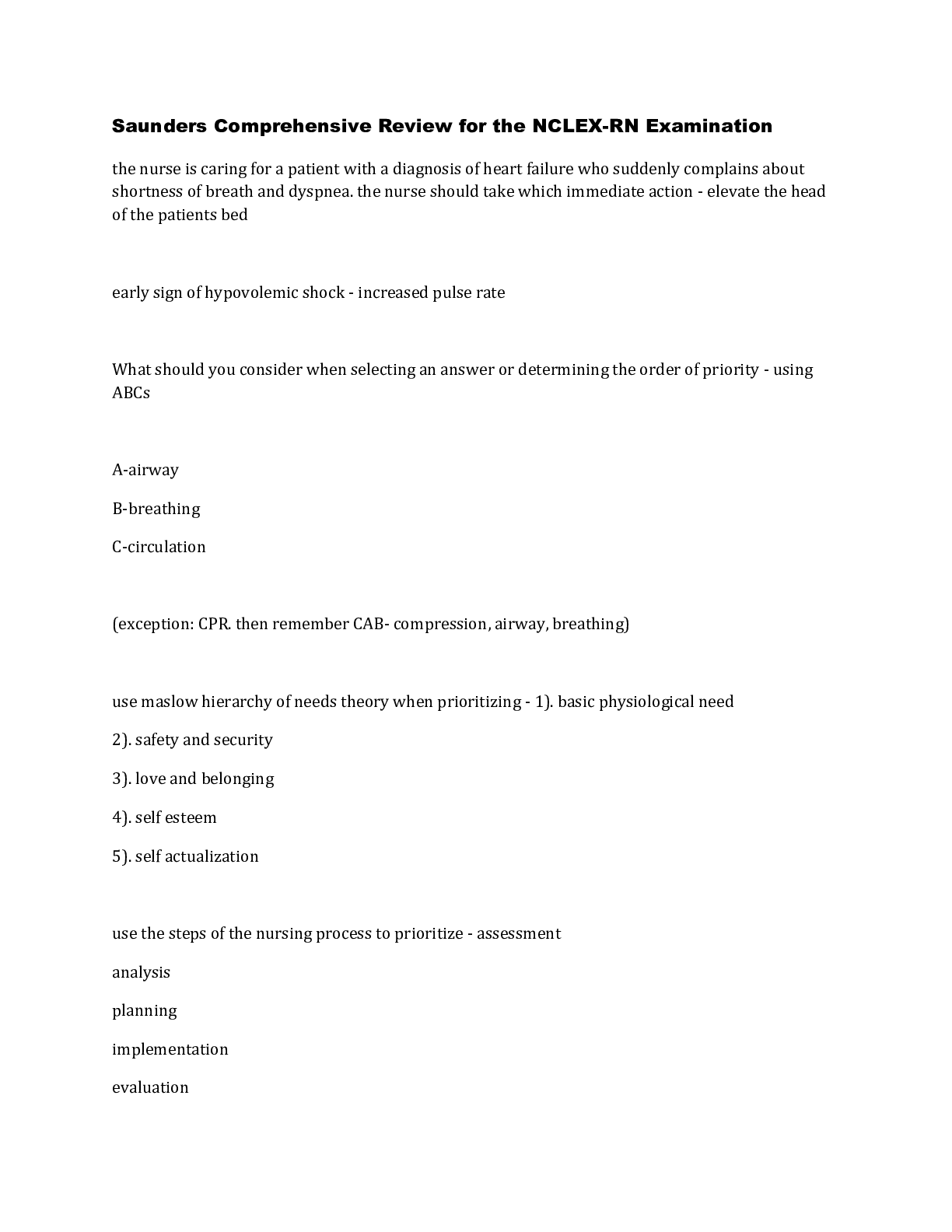*NURSING > NCLEX-RN > C H A P T E R 1 9 Care of the Older Client: From Saunders Comprehensive Review for the NCLEX-RN Exam (All)
C H A P T E R 1 9 Care of the Older Client: From Saunders Comprehensive Review for the NCLEX-RN Examination 8th Edition. (Available: https://bit.ly/2HeJuMt ). Contains Practice questions and Answers with the Rationale, Test-Taking Strategy, Level of Cognitive Ability, Client Needs, Integrated Process, Content Area, Health Problem, Priority Concepts and References
Document Content and Description Below
Priority Concepts Development, Safety I. Aging and Gerontology A. Aging is the biopsychosocial process of change that occurs in a person between birth and death. B. Gerontology is the study of th... e aging process. II. Physiological Changes A. Integumentary system 1. Loss of pigment in hair and skin 2. Wrinkling of the skin 3. Thinning of the epidermis and easy bruising and tearing of the skin 4. Decreased skin turgor, elasticity, and subcutaneous fat 5. Increased nail thickness and decreased nail growth 6. Decreased perspiration 7. Dry, itchy, scaly skin 8. Seborrheic dermatitis and keratosis formation (overgrowth and thickening of certain areas of the skin) B. Neurological system 1. Slowed reflexes 2. Slight tremors and difficulty with fine motor movement 3. Loss of balance 4. Increased incidence of awakening after sleep onset 5. Increased susceptibility to hypothermia and hyperthermia 6. Short-term memory decline possible 7. Long-term memory usually maintained C. Musculoskeletal system 1. Decreased muscle mass and strength and atrophy of muscles 5992. Decreased mobility, range of motion, flexibility, coordination, and stability 3. Change of gait, with shortened step and wider base 4. Posture and stature changes causing a decrease in height, also known as kyphosis (Fig. 19-1) 5. Increased brittleness of the bones due to demineralization 6. Deterioration of joint capsule components The older client is at risk for falls because of the changes that occur in the neurological and musculoskeletal systems. D. Cardiovascular system 1. Diminished energy and endurance, with lowered tolerance to exercise 2. Decreased compliance of the heart muscle can be due to remodeling of the heart after myocardial infarction or long-standing hypertension, with heart valves becoming thicker and more rigid due to calcification 3. Decreased cardiac output and decreased efficiency of blood return to the heart 4. Decreased compensatory response, so less able to respond to increased demands on the cardiovascular system 5. Decreased resting heart rate, which may be medication-related 6. Peripheral pulses can be weak due to lower cardiac output 7. Increased blood pressure but susceptible to postural hypotension, especially with certain cardiac medications such as diuretics E. Respiratory system 1. Decreased stretch and compliance of the chest wall 2. Decreased strength and function of respiratory muscles 3. Decreased size and number of alveoli 4. Respiratory rate usually unchanged 5. Decreased depth of respirations 6. Decreased ability to cough and expectorate sputum F. Hematological system 1. Hemoglobin and hematocrit levels average toward the 600low end of normal 2. Prone to increased blood clotting 3. Decreased protein available for protein-bound medications G. Immune system 1. Tendency for lymphocyte counts to be low with altered immunoglobulin production 2. Decreased resistance to infection and disease H. Gastrointestinal system 1. Decreased caloric needs because of lowered basal metabolic rate 2. Decreased appetite, thirst, and oral intake 3. Decreased lean body weight 4. Slowed gastric motility 5. Increased tendency toward constipation due to poor oral intake and slowed motility 6. Increased susceptibility for dehydration 7. Tooth loss 8. Difficulty in chewing and swallowing food I. Endocrine system 1. Decreased secretion of hormones, with specific changes related to each hormone’s function 2. Decreased metabolic rate 3. Decreased glucose tolerance, with resistance to insulin in peripheral tissues J. Renal/urinary system 1. Decreased kidney size, function, and ability to concentrate urine 2. Decreased glomerular filtration rate 3. Decreased capacity of the bladder 4. Increased residual urine and increased incidence of infection and possibly incontinence 5. Impaired medication excretion K. Reproductive system 1. Decreased testosterone production and decreased size of the testes 2. Changes in the prostate gland, leading to urinary problems such as retention, hesitancy, or stress incontinence, predisposing to urinary tract infections 3. Decreased secretion of hormones with the cessation of menses 6014. Vaginal changes, including decreased muscle tone and lubrication 5. Impotence or sexual dysfunction for both sexes; sexual function varies and depends on general physical condition, mental health status, and medications L. Special senses 1. Decreased visual acuity 2. Decreased accommodation in eyes, requiring increased adjustment time to changes in light 3. Decreased peripheral vision and increased sensitivity to glare 4. Presbyopia and cataract formation 5. Possible loss of hearing ability; low-pitched tones are heard more easily 6. Inability to discern taste of food 7. Decreased sense of smell 8. Changes in touch sensation 9. Decreased pain awareness III. Psychosocial Concerns A. Adjustment to deterioration in physical and mental health and well-being B. Threat to independent functioning and fear of becoming a burden to loved ones C. Adjustment to retirement and loss of income D. Loss of skills and competencies developed early in life E. Coping with changes in role function and social life F. Diminished quantity and quality of relationships and coping with loss G. Dependence on governmental and social systems H. Access to social support systems I. Costs of health care and medications J. Loss of independence in living, driving, and other daily functions IV. Mental Health Concerns A. Depression: The increased dependency that older adults may experience can lead to hopelessness, helplessness, lowered sense of self-control, and decreased self-esteem and self-worth; these changes can interfere with daily functioning and lead to depression. B. Grief: Client reacts to the perception of loss, including physical, psychological, social, and spiritual aspects. C. Isolation: Client is alone and desires contact with others but is unable to make that contact. 602D. Suicide: Depression can lead to thoughts of self-harm. E. Depression differs from delirium and dementia (Table 19-1). Any suicide threat made by an older client should be taken seriously. V. Pain A. Description 1. Pain can occur from numerous causes and most often occurs from degenerative changes in the musculoskeletal system. 2. The nurse needs to monitor the older client closely for signs of pain; failure to alleviate pain in the older client can lead to functional limitations affecting his or her ability to function independently. B. Assessment 1. Restlessness 2. Verbal reporting of pain 3. Agitation 4. Moaning 5. Crying C. Interventions 1. Monitor the client for signs and symptoms of pain. 2. Identify the type and pattern of pain. 3. Identify the precipitating factor(s) for the pain. 4. Monitor the impact of the pain on activities of daily living. 5. Set realistic goals for pain management, and use functional outcome as a measure of attaining the goal. 6. Provide pain relief through measures such as distraction, relaxation, massage, biofeedback, ice, heat, and stretching. 7. Administer pain medication as prescribed, and instruct the client in its use. Opioid use should be avoided as much as possible. 8. Over-the-counter preparations such as acetaminophen, ibuprofen, lidocaine patches, and creams may be prescribed. 9. Evaluate the effects of pain-reducing measures. VI. Infection (Box 19-1) A. Altered mental status is a common sign of infection in the older adult, especially infection of the urinary tract. B. Carefully monitor the older adult with infection because of the diminished and altered immune response. C. Nonspecific symptoms may indicate illness or infection (see Box 19-1). VII. Medications 603A. Major problems with prescriptive medications include adverse effects, medication interactions, medication errors, nonadherence, polypharmacy, and cost. See Box 19-2 for information on medications to avoid in the older adult client. This information is based on Beers Criteria from the American Geriatrics Society. Information on this criteria and a full list of medications to avoid can be located at https://geriatricscareonline.org/ProductAbstract/americangeriatrics-society-updated-beers-criteria-for-potentiallyinappropriate-medication-use-in-older-adults/CL001 B. Determine the use of over-the-counter medications. C. Polypharmacy 1. Routinely monitor the number of prescription and nonprescription medications used and determine whether any can be eliminated or combined. 2. Keep the use of medications to a minimum. 3. Overprescribing medications leads to increased problems with more side and adverse effects, increased interaction between medications, duplication of medication treatment, diminished quality of life, and increased costs. D. Medication dosages normally are prescribed at one-third to onehalf of normal adult dosages. E. Closely monitor the client for adverse effects and response to therapy because of the increased risk for medication toxicity (see Box 19-2). F. Assess for medication interactions in the client taking multiple medications. G. Advise the client to use one pharmacy and notify the consulting primary health care provider(s) of the medications taken. A common sign of an adverse reaction to a medication in the older client is a sudden change in mental status. H. Safety measures for medication administration (see Priority Nursing Actions box) 1. The client should be in a sitting position when taking medication. 2. The mouth is checked for dryness because medication may stick and dissolve in the mouth. 3. Liquid preparations can be used if the client has difficulty swallowing tablets. 4. Tablets can be crushed if necessary and given with textured food (nectar, applesauce) if not contraindicated. Practice Questions 174. The nurse is providing medication instructions to an older client who is taking digoxin daily. The nurse explains to the client that decreased lean body mass and decreased glomerular filtration rate, which are age-related body changes, could place the client at risk for which complication with medication therapy? 1. Decreased absorption of digoxin 2. Increased risk for digoxin toxicity 3. Decreased therapeutic effect of digoxin 4. Increased risk for side effects related to digoxin 175. The nurse is caring for an older client in a long-term care facility. Which action contributes to encouraging autonomy in the client? 1. Planning meals 2. Decorating the room 3. Scheduling haircut appointments 4. Allowing the client to choose social activities 176. The home care nurse is visiting an older client whose spouse died 6 months ago. Which behaviors by the client indicates effective coping? Select all that apply. 1. Neglecting personal grooming 2. Looking at old snapshots of family 3. Participating in a senior citizens program 4. Visiting the spouse’s grave once a month 5. Decorating a wall with the spouse’s pictures and awards received 177. The nurse is providing instructions to the assistive personnel (AP) regarding care of an older client with hearing loss. What should the nurse tell the AP about older clients with hearing loss? 1. They are often distracted. 2. They have middle ear changes. 3. They respond to low-pitched tones. 4. They develop moist cerumen production. 178. The nurse is providing an educational session to new employees, and the topic is abuse of the older client. The nurse helps the employees identify which client as most typically a victim of abuse? 1. A man who has moderate hypertension 2. A man who has newly diagnosed cataracts 3. A woman who has advanced Parkinson’s disease 4. A woman who has early diagnosed Lyme disease 179. The nurse is performing an assessment on an older client who is having difficulty sleeping at night. Which statement by the client indicates the need for further teaching regarding measures to improve sleep? 1. “I swim 3 times a week.” 2. “I have stopped smoking cigars.” 6103. “I drink hot chocolate before bedtime.” 4. “I read for 40 minutes before bedtime.” 180. The visiting nurse observes that the older male client is confined by his daughter-in-law to his room. When the nurse suggests that he walk to the den and join the family, he says, “I’m in everyone’s way; my daughter-in-law needs me to stay here.” Which is the most important action for the nurse to take? 1. Say to the daughter-in-law, “Confining your father-in-law to his room is inhumane.” 2. Suggest to the client and daughter-in-law that they consider a nursing home for the client. 3. Say nothing, because it is best for the nurse to remain neutral and wait to be asked for help. 4. Suggest appropriate resources to the client and daughter-in-law, such as respite care and a senior citizens center. 181. The nurse is performing an assessment on an older adult client. Which assessment data would indicate a potential complication associated with the skin? 1. Crusting 2. Wrinkling 3. Deepening of expression lines 4. Thinning and loss of elasticity in the skin 182. The home health nurse is visiting a client for the first time. While assessing the client’s medication history, it is noted that there are 19 prescriptions and several over-the-counter medications that the client has been taking. Which intervention should the nurse take first? 1. Check for medication interactions. 2. Determine whether there are medication duplications. 3. Determine whether a family member supervises medication administration. 4. Call the prescribing primary health care provider (PHCP) and report polypharmacy. 183. The long-term care nurse is performing assessments on several of the residents. Which are normal age-related physiological changes the nurse should expect to note? Select all that apply. 1. Increased heart rate 2. Decline in visual acuity 3. Decreased respiratory rate 4. Decline in long-term memory 5. Increased susceptibility to urinary tract infections 6. Increased incidence of awakening after sleep ons [Show More]
Last updated: 1 year ago
Preview 1 out of 21 pages

Reviews( 0 )
Recommended For You
*NURSING> NCLEX-RN > TEST BANK NCLEX QUESTIONS AND ANSWERS ALL UPDATED (All)

TEST BANK NCLEX QUESTIONS AND ANSWERS ALL UPDATED
ST BANK NCLEX QUESTIONS AND ANSWERS ALL UPDATED WELL 2021 QUESTIONS 1-15 Ref # 4366 The nurse receives a client from the post anesthesia care unit following a left femoral-popliteal bypass gr aft proc...
By Expert , Uploaded: Mar 14, 2021
$12
*NURSING> NCLEX-RN > TEST BANK NCLEX QUESTIONS AND ANSWERS (All)

TEST BANK NCLEX QUESTIONS AND ANSWERS
TEST BANK NCLEX QUESTIONS AND ANSWERS ALL UPDATED WELL 2021 QUESTIONS 1-15 Ref # 4366 The nurse receives a client from the post anesthesia care unit following a left femoral-popliteal bypass gr...
By klaus , Uploaded: Jan 25, 2021
$12
*NURSING> NCLEX-RN > SAUNDERS NCLEXRN EXAMINATION REVISON CONTENT. QUESTIONS AND ANSWERS (All)

SAUNDERS NCLEXRN EXAMINATION REVISON CONTENT. QUESTIONS AND ANSWERS
SAUNDERS QUESTIONS AND ANSWERS-NCLEX-RN EXAMINATION 1) The nurse is providing discharge instructions to a Chinese American client regarding prescribed dietary modifications. During th...
By QuizMaster , Uploaded: Aug 05, 2020
$9
*NURSING> NCLEX-RN > NCLEX-RN EXAM QUESTIONS AND ANSWERS (LATEST VERSION) (All)
NCLEX-RN EXAM QUESTIONS AND ANSWERS (LATEST VERSION)
2022/2023 NCLEX-RN EXAM QUESTIONS AND ANSWERS (LATEST VERSION)/////////////2022/2023 NCLEX-RN EXAM QUESTIONS AND ANSWERS (LATEST VERSION)/////////2022/2023 NCLEX-RN EXAM QUESTIONS AND ANSWERS (LATEST...
By Rixx Dennis , Uploaded: Jun 02, 2022
$28
*NURSING> NCLEX-RN > HESI NCLEX-RN FUNDAMENTALS QUESTIONS AND ANSWERS EXPLAINED (By TestMango.com),100% CORRECT (All)

HESI NCLEX-RN FUNDAMENTALS QUESTIONS AND ANSWERS EXPLAINED (By TestMango.com),100% CORRECT
HESI NCLEX-RN FUNDAMENTALS QUESTIONS AND ANSWERS EXPLAINED (By TestMango.com) 1. A 20-year-old female client with a noticeable body odor has refused to shower for the last 3 days. She states, "...
By securegrades , Uploaded: Feb 20, 2021
$16
*NURSING> NCLEX-RN > NCLEX-RN Test Bank 2022 (828 Questions and answers) (All)

NCLEX-RN Test Bank 2022 (828 Questions and answers)
NCLEX-RN Test Bank 2022 (828 Questions and answers)
By A LEVELS , Uploaded: Jul 24, 2022
$20
*NURSING> NCLEX-RN > Saunders Comprehensive Review for the NCLEX-RN Examination (All)

Saunders Comprehensive Review for the NCLEX-RN Examination
Saunders Comprehensive Review for the NCLEX-RN Examination the nurse is caring for a patient with a diagnosis of heart failure who suddenly complains about shortness of breath and dyspnea. the nurse...
By Professor_Chue , Uploaded: Jul 23, 2022
$9
Health Care> NCLEX-RN > NCLEX-RN EXAM REVIEW 2022 Questions and Answers (All)

NCLEX-RN EXAM REVIEW 2022 Questions and Answers
When selecting an NCLEX answer or determining the order of priority what should you remember or use and what is the exception? - ANSWER Use the ABC rule: Airway breathing, and circulation. The excepti...
By MARKALLAN , Uploaded: Jul 19, 2022
$7
Health Care> NCLEX-RN > NCLEX-RN EXAM REVIEW 2022 Questions and Answers (All)

NCLEX-RN EXAM REVIEW 2022 Questions and Answers
When selecting an NCLEX answer or determining the order of priority what should you remember or use and what is the exception? - ANSWER Use the ABC rule: Airway breathing, and circulation. The excepti...
By Nancylect , Uploaded: Jul 19, 2022
$7
Health Care> NCLEX-RN > NCLEX RN Versions 1 -12 (Latest) With 850 Questions And Answers {Solved Solution} Guaranteed 100% (All)

NCLEX RN Versions 1 -12 (Latest) With 850 Questions And Answers {Solved Solution} Guaranteed 100%
NCLEX RN Versions 1 -12 (Latest) With 850 Questions And Answers {Solved Solution} Guaranteed 100%NCLEX RN Versions 1 -12 (Latest) With 850 Questions And Answers {Solved Solution} Guaranteed 100%NCLEX...
By Doctor Immanuel , Uploaded: Jul 15, 2022
$18
Document information
Connected school, study & course
About the document
Uploaded On
Oct 22, 2020
Number of pages
21
Written in
Additional information
This document has been written for:
Uploaded
Oct 22, 2020
Downloads
0
Views
65






